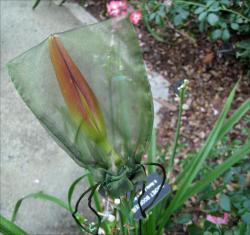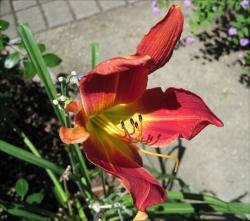I hybridize (or more accurately, "pollen dab") daylilies, and every season it has been the same old story. The carpenter bees are out there zooming among the daylilies, busily harvesting the pollen that I need. I am not an early bird in the garden (we are very much night owls here), so the bees often get to the daylilies before I do. Even when they leave behind enough pollen to be workable, this pollen might possibly have been contaminated with pollen from other blooms they visited.
What's a girl to do?
As Oscie Whatley noted in Part III of his series "The Art of Hybridizing":
"...Several types of bees collect pollen for their own use and robbing you of a cross doesn't bother them a bit. The best way to counter this is to collect the pollen anthers the previous day or be an early riser. Also, some light-weight screening material can be used."
As previously noted, I am not an early riser. Neither do I like the idea of prying open blooms in order to steal the pollen anthers. That seems like it would damage the blooms, and who wants to be out in the garden collecting pollen the evening before bloom, when the mosquitoes are coming out? I also don't like the idea of plucking a bud and bringing it inside to open up. It's not clear how well that would work for one bud only, and I'm not about to sacrifice a scape. For that matter, I don't want to rob the garden of even one bloom, and what if I want pollen from several different daylilies?
That leaves Oscie's third suggestion: screening.
As it turns out, I have a stash of sheer organza mesh bags with drawstrings, which I use for various small gifts. I tried a couple of the small bags on blooms whose pollen I wished to save. I am happy to report that the buds fit into the lightweight bags (which can be obtained in different sizes, styles of bottom, and colors), and the drawstrings, when pulled tight, definitely keep the bees out. I have been able to go out into the garden in mid-late morning, after every unprotected bloom has been raided, and have been able to harvest all of the pollen from the protected blooms. Better yet, if one is paranoid about the purity of their crosses (I am not), the pistil can also be protected from bee crosses using this method.

Bagged bud on 'Rocket Booster' the night before bloom; note the drawstrings cinched tight

Bagged but opened bloom on 'Rocket Booster', noon

Bag removed from 'Rocket Booster'

The pollen looks good! And it's all MINE!

Bloom of 'Rocket Booster' opening up a bit more
The only downsides to this approach are that the protected flower may not open completely because of having been constrained by the bag (this might be alleviated by choosing appropriate bag sizes), and if you want to protect a lot of flowers, that's a lot of bags. However, one less-than-fully-opened bloom per clump is, in my opinion, a small price to pay in exchange for all of its pristine pollen, and fortunately the bags aren't all that expensive. A quantity of 10-30 standard or flat bottomed bags costs less than $12 (the larger bags come in lots of 10 each; the smaller in lots of 30 each). http://www.papermart.com/sheer... Now that I know this approach works, I probably will be getting more (and bigger) bags just for the garden, to protect the pollen.
I may also try this approach to protect the pods (or rather, to prevent the loss of seeds spilled from the pods). That has been another perennial problem for me (various attempts to solve it, such as rubber-banding the pods, having failed). This use would require one of the two smaller-size bags per pod, unless I have the foresight to cross adjacent pods with the same pollen parent. But hey, at 30 bags for $3.30 - $3.60, that's a lot of pods that I can protect, and it will be nice to no longer worry about spilled seeds, or to have to guess "Who's your daddy?" when the spring volunteers pop up. And just to make sure that I don't accidentally leave any pods behind, maybe I should go for bag colors other than the various shades of green (though green bags blend very nicely into the garden). There are so many choices of bag colors available, I could even get bags that are color-coordinated to the blooms (for protecting those early pods while the clump is still in bloom).
Time for another order of bags!
| Thread Title | Last Reply | Replies |
|---|---|---|
| Bag it by Mariel | Sep 10, 2016 9:55 PM | 1 |
| My Favorite Method by Reine | Sep 10, 2016 9:49 PM | 1 |
| Bag Lady by Lalambchop1 | Sep 9, 2016 3:08 PM | 1 |
| Untitled by Karen | Sep 8, 2016 9:10 PM | 2 |
| Organza bags by RickCorey | Sep 8, 2016 6:56 PM | 4 |
| Cut off the petals by Xeramtheum | Sep 8, 2016 3:39 PM | 4 |
| Wonderful tip! by plantladylin | Sep 8, 2016 3:22 PM | 5 |
| Great idea by crawgarden | Sep 7, 2016 10:22 PM | 1 |